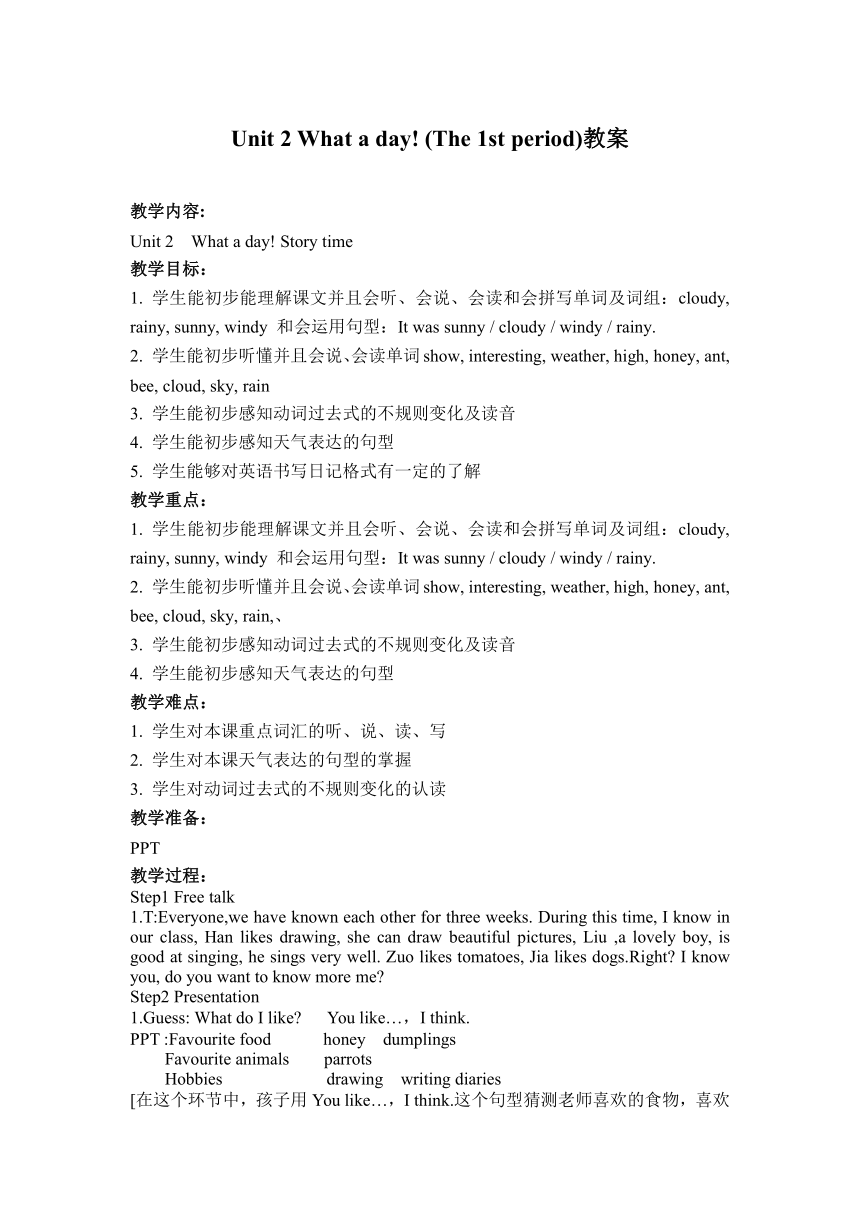Unit 2 What a day! period 1 教案
文档属性
| 名称 | Unit 2 What a day! period 1 教案 |  | |
| 格式 | docx | ||
| 文件大小 | 29.9KB | ||
| 资源类型 | 教案 | ||
| 版本资源 | 牛津译林版 | ||
| 科目 | 英语 | ||
| 更新时间 | 2021-12-18 09:12:57 | ||
图片预览

文档简介
Unit 2 What a day! (The 1st period)教案
教学内容:
Unit 2 What a day! Story time
教学目标:
1. 学生能初步能理解课文并且会听、会说、会读和会拼写单词及词组:cloudy, rainy, sunny, windy 和会运用句型:It was sunny / cloudy / windy / rainy.
2. 学生能初步听懂并且会说、会读单词show, interesting, weather, high, honey, ant, bee, cloud, sky, rain
3. 学生能初步感知动词过去式的不规则变化及读音
4. 学生能初步感知天气表达的句型
5. 学生能够对英语书写日记格式有一定的了解
教学重点:
1. 学生能初步能理解课文并且会听、会说、会读和会拼写单词及词组:cloudy, rainy, sunny, windy 和会运用句型:It was sunny / cloudy / windy / rainy.
2. 学生能初步听懂并且会说、会读单词show, interesting, weather, high, honey, ant, bee, cloud, sky, rain,、
3. 学生能初步感知动词过去式的不规则变化及读音
4. 学生能初步感知天气表达的句型
教学难点:
1. 学生对本课重点词汇的听、说、读、写
2. 学生对本课天气表达的句型的掌握
3. 学生对动词过去式的不规则变化的认读
教学准备:
PPT
教学过程:
Step1 Free talk
1.T:Everyone,we have known each other for three weeks. During this time, I know in our class, Han likes drawing, she can draw beautiful pictures, Liu ,a lovely boy, is good at singing, he sings very well. Zuo likes tomatoes, Jia likes dogs.Right I know you, do you want to know more me
Step2 Presentation
1.Guess: What do I like You like…,I think.
PPT :Favourite food honey dumplings
Favourite animals parrots
Hobbies drawing writing diaries
[在这个环节中,孩子用You like…,I think.这个句型猜测老师喜欢的食物,喜欢的动物和兴趣爱好,更多的了解老师,拉近师生之间的距离,同时学习课文中的一些新单词,为课文的学习降低难度。]
2.Learn the new words
T: I like drawing ,please enjoy my pictures.
PPT: sunny cloudy windy rainy
T: These pictures are about weather
Learn the word : weather
[这个环节接着上一环节,欣赏老师的简笔画,都是关于天气的,这四个单词也是本课需要解决的单词。Unit 2的Story time 中有许多新单词,而且还涉及了许多不规则动词的过去式,如果都放到课文中学习,学生会感到很吃力。这也是为什么在这儿解决关于天气的单词的原因,接着上面一个说画画的环节解决图画中的单词,水到渠成。]
3.揭题
T: Our friend Yang Ling likes drawing and writing diaries. This is Yang Ling’s diary.
PPT: Yang Ling’s diary
T: What day What date (Note: the diary format)
This class, we’ll learn Unit 2 What a day!
4.Enjoy and say
T: Yang Ling drew some pictures for the diary, let’s enjoy some pictures and answer: What can you see
PPT: some pictures
Check the answer
[直接出示语篇对孩子来说一点兴趣都没有,但五彩的图片能激发孩子学习的热情。欣赏图片,先从图片上了解课文大概讲了什么。]
5.Watch read and match
(1)T: Yang Ling wrote the diary and drew the pictures. Can you match the pictures and the sentences First, let’s watch(watch the cartoon)
(2)Read and match
(3)Check the answer
[这个环节是整体感知课文,在此基础上学生把文字和对应的图片配对,在配对时学习不规则动词的过去式,学生初步感知就行。]
6.Read and order(板书)
(1)默读杨玲的日记,按照事件的时间及先后顺序排列句子
(2)Read the sentences.
(3)Pay attention to the past forms of these verbs. They are irregular.
[学生欣赏了图片,进行了图文匹配,再把这些打乱的句子进行整理,就能看出学生是否真正理解了课文的大意。]
7.Read and judge(板书)
P18
[从关注整体到关注课文的细节,这个任务是帮助学生深入理解课文]最
8.Let’s read
Read after the tape
9.Let’s think: What do you think of her day Why (板书)
[学课文,读课文,最后是对课文的感情升华,总结课文]
Step3 Consolidation
Try to retell the text according to the design on the blackboard.
板书设计:
went …by bike happy
saw …parrots… interesting
flew kites
saw ants and bees sad
hungry and wet terrible
wonderful
教学反思:
1.在教案设计中注重课程的开发和利用,增强学生综合运用能力,使课堂与生活“链接”。
2.引导学生将语言知识联系到自己的生活中,让孩子们主动积极交流,尽量在课堂上开发学生的自主学习、合作交流、合作探究的能力,发展学习策略,培养创新能力。
3.从课前的教学设计到课中的教学过程,教者始终努力凸现学生的主体地位,赋予学生以广阔的学习空间,引导学生全身心地沉浸到教材意境中,真正做到学以致用,联系生活。
4.教师要学会指导学生通过多种形式进行朗读,帮助学生记忆单词和句型。
5.教师能灵活把握教材,做到详略处理得当。正确处理教与学的关系,既充分发挥小学生活泼好动、乐于表现的天性,又能使他们在游戏竞争中学习知识。
教学内容:
Unit 2 What a day! Story time
教学目标:
1. 学生能初步能理解课文并且会听、会说、会读和会拼写单词及词组:cloudy, rainy, sunny, windy 和会运用句型:It was sunny / cloudy / windy / rainy.
2. 学生能初步听懂并且会说、会读单词show, interesting, weather, high, honey, ant, bee, cloud, sky, rain
3. 学生能初步感知动词过去式的不规则变化及读音
4. 学生能初步感知天气表达的句型
5. 学生能够对英语书写日记格式有一定的了解
教学重点:
1. 学生能初步能理解课文并且会听、会说、会读和会拼写单词及词组:cloudy, rainy, sunny, windy 和会运用句型:It was sunny / cloudy / windy / rainy.
2. 学生能初步听懂并且会说、会读单词show, interesting, weather, high, honey, ant, bee, cloud, sky, rain,、
3. 学生能初步感知动词过去式的不规则变化及读音
4. 学生能初步感知天气表达的句型
教学难点:
1. 学生对本课重点词汇的听、说、读、写
2. 学生对本课天气表达的句型的掌握
3. 学生对动词过去式的不规则变化的认读
教学准备:
PPT
教学过程:
Step1 Free talk
1.T:Everyone,we have known each other for three weeks. During this time, I know in our class, Han likes drawing, she can draw beautiful pictures, Liu ,a lovely boy, is good at singing, he sings very well. Zuo likes tomatoes, Jia likes dogs.Right I know you, do you want to know more me
Step2 Presentation
1.Guess: What do I like You like…,I think.
PPT :Favourite food honey dumplings
Favourite animals parrots
Hobbies drawing writing diaries
[在这个环节中,孩子用You like…,I think.这个句型猜测老师喜欢的食物,喜欢的动物和兴趣爱好,更多的了解老师,拉近师生之间的距离,同时学习课文中的一些新单词,为课文的学习降低难度。]
2.Learn the new words
T: I like drawing ,please enjoy my pictures.
PPT: sunny cloudy windy rainy
T: These pictures are about weather
Learn the word : weather
[这个环节接着上一环节,欣赏老师的简笔画,都是关于天气的,这四个单词也是本课需要解决的单词。Unit 2的Story time 中有许多新单词,而且还涉及了许多不规则动词的过去式,如果都放到课文中学习,学生会感到很吃力。这也是为什么在这儿解决关于天气的单词的原因,接着上面一个说画画的环节解决图画中的单词,水到渠成。]
3.揭题
T: Our friend Yang Ling likes drawing and writing diaries. This is Yang Ling’s diary.
PPT: Yang Ling’s diary
T: What day What date (Note: the diary format)
This class, we’ll learn Unit 2 What a day!
4.Enjoy and say
T: Yang Ling drew some pictures for the diary, let’s enjoy some pictures and answer: What can you see
PPT: some pictures
Check the answer
[直接出示语篇对孩子来说一点兴趣都没有,但五彩的图片能激发孩子学习的热情。欣赏图片,先从图片上了解课文大概讲了什么。]
5.Watch read and match
(1)T: Yang Ling wrote the diary and drew the pictures. Can you match the pictures and the sentences First, let’s watch(watch the cartoon)
(2)Read and match
(3)Check the answer
[这个环节是整体感知课文,在此基础上学生把文字和对应的图片配对,在配对时学习不规则动词的过去式,学生初步感知就行。]
6.Read and order(板书)
(1)默读杨玲的日记,按照事件的时间及先后顺序排列句子
(2)Read the sentences.
(3)Pay attention to the past forms of these verbs. They are irregular.
[学生欣赏了图片,进行了图文匹配,再把这些打乱的句子进行整理,就能看出学生是否真正理解了课文的大意。]
7.Read and judge(板书)
P18
[从关注整体到关注课文的细节,这个任务是帮助学生深入理解课文]最
8.Let’s read
Read after the tape
9.Let’s think: What do you think of her day Why (板书)
[学课文,读课文,最后是对课文的感情升华,总结课文]
Step3 Consolidation
Try to retell the text according to the design on the blackboard.
板书设计:
went …by bike happy
saw …parrots… interesting
flew kites
saw ants and bees sad
hungry and wet terrible
wonderful
教学反思:
1.在教案设计中注重课程的开发和利用,增强学生综合运用能力,使课堂与生活“链接”。
2.引导学生将语言知识联系到自己的生活中,让孩子们主动积极交流,尽量在课堂上开发学生的自主学习、合作交流、合作探究的能力,发展学习策略,培养创新能力。
3.从课前的教学设计到课中的教学过程,教者始终努力凸现学生的主体地位,赋予学生以广阔的学习空间,引导学生全身心地沉浸到教材意境中,真正做到学以致用,联系生活。
4.教师要学会指导学生通过多种形式进行朗读,帮助学生记忆单词和句型。
5.教师能灵活把握教材,做到详略处理得当。正确处理教与学的关系,既充分发挥小学生活泼好动、乐于表现的天性,又能使他们在游戏竞争中学习知识。
